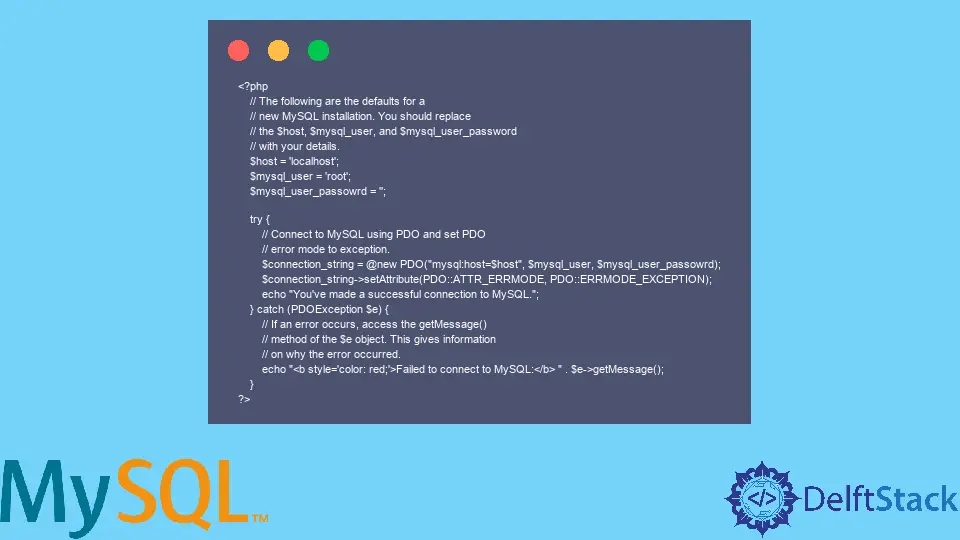PHP 中已棄用的 Mysql_connect 的解決方案

本文將教你解決 PHP 中已棄用的 mysql_connect 的解決方案。這些解決方案包括 mysqli_connect(過程和 OOP)和 PHP 資料物件 (PDO)。
使用程式 Mysqli_connect 連線到 MySQL
mysqli_connect 允許你使用過程程式設計連線到你的 MySQL 資料庫。因此,你可以使用以下演算法:
-
定義資料庫連線詳細資訊。
-
使用
mysqli_connect連線。 -
如果連線成功,則顯示成功訊息。
-
如果連線失敗,則顯示錯誤訊息。
在步驟 2 中發生錯誤之前,此演算法工作正常。此類錯誤可能是不正確的資料庫詳細資訊。
當 PHP 遇到這些不正確的細節時,它會丟擲一個 Fatal Error 異常。因此,程式碼不會進入第 3 步或第 4 步,你將在其中顯示錯誤訊息。
為了解決這個問題,我們必須關閉 MySQL 錯誤報告並禁止警告。通過這樣做,當發生錯誤時,你將阻止使用者看到敏感細節,同時,你可以顯示自定義錯誤訊息。
話雖如此,以下是修改後的演算法:
-
定義資料庫連線詳細資訊。
-
關閉 MySQL 錯誤報告。
-
使用
mysqli_connect連線並抑制警告。 -
如果連線成功,則顯示成功訊息。
-
如果連線失敗,則顯示錯誤訊息。
下面是這個演算法的實現:
<?php // The following are the defaults for a // new MySQL installation. You should replace // the $host, $mysql_user, and $mysql_user_password // with your details. $host = 'localhost'; $mysql_user = 'root'; $mysql_user_passowrd = ''; // Turn off error reports like "Fatal Errors". // Such reports can contain too much sensitive // information that no one should see. Also, // turning off error reports allows us to handle // connection error in an if/else statement. mysqli_report(MYSQLI_REPORT_OFF); // If there is an error in the connection string, // PHP will produce a Warning message. For security // and private reasons, it's best to suppress the // warnings using the '@' sign $connect_to_mysql = @mysqli_connect($host, $mysql_user, $mysql_user_passowrd); if (!$connect_to_mysql) { echo "<b style='color: red;'>Failed to connect to MySQL.</b>"; } else { echo "You've made a successful connection to MySQL."; } ?> 成功連線的輸出:
You've made a successful connection to MySQL. 連線失敗的輸出:
<b style='color: red;'>Failed to connect to MySQL.</b> 使用物件導向程式設計連線到 MySQL
使用 OOP 和 mysqli_connect,你可以使用 new mysqli() 建立資料庫連線。與程式技術一樣,你必須將連線詳細資訊傳遞給 new mysqli()。
但是,這些細節中可能存在錯誤,因此我們將使用 try...catch 塊進行錯誤處理。首先,我們將連線詳細資訊放在 try 塊中,如果發生錯誤,我們將在 catch 塊中捕獲它們。
在下文中,與 MySQL 的連線使用 OOP 版本的 mysqli_connect。你還會注意到我們已經抑制了連線字串中的錯誤。
<?php // The following are the defaults for a // new MySQL installation. You should replace // the $host, $mysql_user, and $mysql_user_password // with your details. $host = 'localhost'; $mysql_user = 'root'; $mysql_user_passowrd = ''; try { // Connect to the database using the OOP style // of mysqli. $connection_string = @new mysqli($host, $mysql_user, $mysql_user_passowrd); echo "You've made a successful connection to MySQL."; } catch (Exception $e) { // If an error occurs, access the getMessage() // method of the $e object. This gives information // on why the error occurred. echo "<b style='color: red;'>Failed to connect to MySQL :</b> " . $e->getMessage(); } ?> 成功連線的輸出:
You've made a successful connection to MySQL. 連線失敗的輸出:
<b style='color: red;'>Failed to connect to MySQL :</b> Access denied for user ''@'localhost' (using password: NO) 使用 PDO 連線到 MySQL
你可以使用 PDO 連線到 MySQL,並且你應該使用 try...catch 塊捕獲錯誤。後者的工作方式與你在 OOP 部分中學習的方式相同。
此外,當錯誤發生時,你的使用者不會看到敏感的錯誤訊息。現在,下面是連線 MySQL 的 PDO 版本:
<?php // The following are the defaults for a // new MySQL installation. You should replace // the $host, $mysql_user, and $mysql_user_password // with your details. $host = 'localhost'; $mysql_user = 'root'; $mysql_user_passowrd = ''; try { // Connect to MySQL using PDO and set PDO // error mode to exception. $connection_string = @new PDO("mysql:host=$host", $mysql_user, $mysql_user_passowrd); $connection_string->setAttribute(PDO::ATTR_ERRMODE, PDO::ERRMODE_EXCEPTION); echo "You've made a successful connection to MySQL."; } catch (PDOException $e) { // If an error occurs, access the getMessage() // method of the $e object. This gives information // on why the error occurred. echo "<b style='color: red;'>Failed to connect to MySQL:</b> " . $e->getMessage(); } ?> 連線成功的輸出:
You've made a successful connection to MySQL. 連線失敗的輸出:
Failed to connect to MySQL: SQLSTATE[HY000] [1045] Access denied for user 'root'@'localhost' (using password: YES) Habdul Hazeez is a technical writer with amazing research skills. He can connect the dots, and make sense of data that are scattered across different media.
LinkedIn